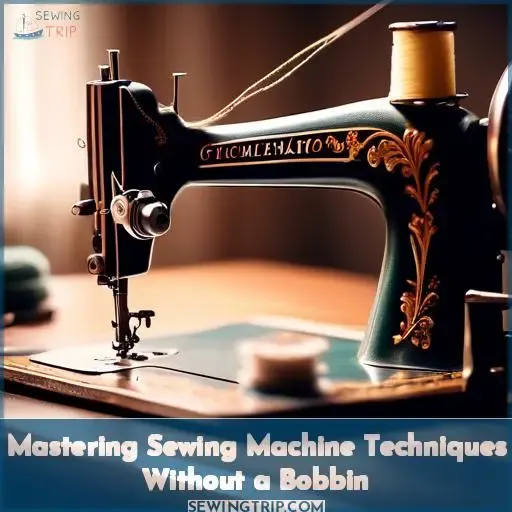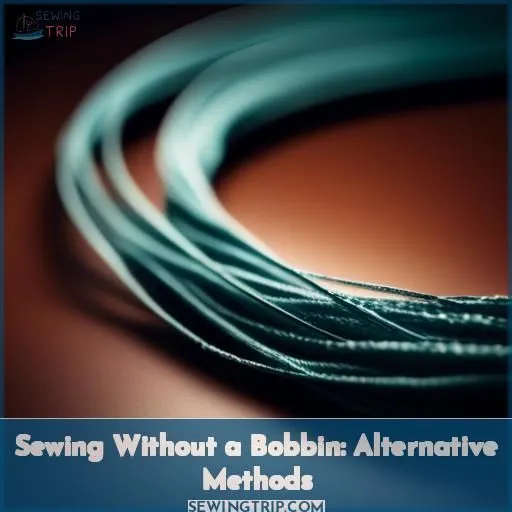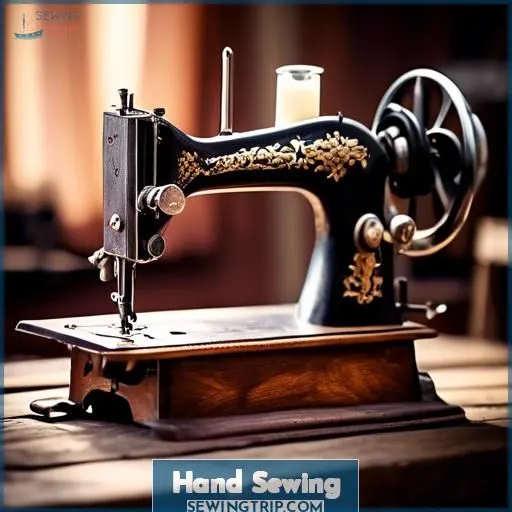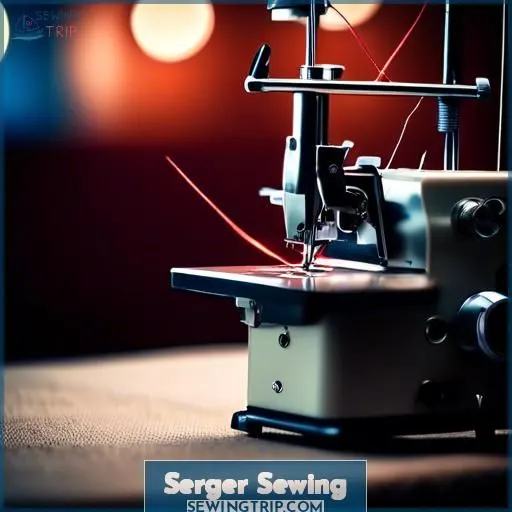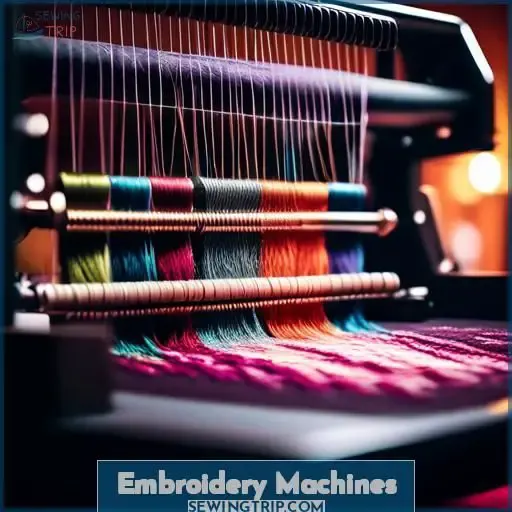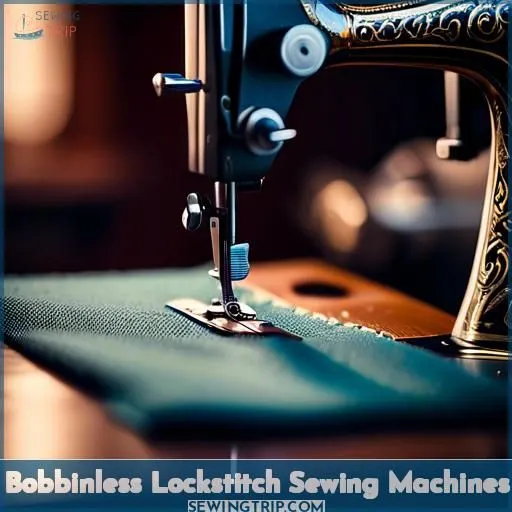This site is supported by our readers. We may earn a commission, at no cost to you, if you purchase through links.
Certainly, it is possible to utilize a sewing machine sans bobbin. In lieu of a bobbin, alternative methods abound, including manual sewing, overlock sewing, and embroidery machines. Furthermore, bobbinless lockstitch sewing machines have been meticulously engineered for this very purpose. These machines boast a distinct threading mechanism that obviates the need for a bobbin.
However, it is imperative to acknowledge that sewing without a bobbin may pose certain hurdles, such as attachment, tension, tangling, and snagging. Nevertheless, with the appropriate techniques and machines, these methods can be mastered, opening up a realm of creative potential.
Table Of Contents
Key Takeaways
- Sewing without a bobbin is possible through alternative methods such as manual sewing, overlock sewing, and embroidery machines.
- Bobbinless lockstitch sewing machines are specifically designed to sew without a bobbin, offering a unique stitch formation and thread management.
- Despite the challenges of sewing without a bobbin, such as tension and tangling, these methods can be mastered with practice and the right techniques.
- Embroidery machines require regular cleaning, oiling, and maintenance to ensure optimal performance and longevity.
Can You Use a Sewing Machine Without a Bobbin?
Yes, you can use a sewing machine without a bobbin, but the results may not be as effective or efficient as with a bobbin. There are alternative methods for sewing without a bobbin, such as hand sewing or using a serger machine. Hand sewing allows for precise control and can be done with minimal tools, while serger machines use loopers to feed the thread and interlock it with the fabric, eliminating the need for a bobbin. However, these alternative methods may not be suitable for all sewing projects and machines.
Sewing Without a Bobbin: Alternative Methods
Sewing without a bobbin may appear intimidating, but there are alternative ways to produce stitches. One approach is to use spools of thread rather than wound bobbins. This method offers advantages such as reduced time spent changing bobbins, eliminated frustration from thread depletion, and extended sewing sessions without interruption.
However, it also presents challenges such as finding a way to secure the spool to the machine, adjusting the thread tension, preventing thread entanglement, and keeping thread from snagging in the machine. To avoid over-tightening the thread, it’s essential to adjust the tension settings on your sewing machine.
Note that there are no known adapters for a bobbin case to accommodate a spool of thread, and only one machine is known to have used a whole spool of thread several years ago. If you’re considering this method, be prepared to find solutions for attachment, tension, tangling, and thread catching.
Hand Sewing
Hand sewing is a time-honored technique that doesn’t require a bobbin. Instead, you’ll use a needle and thread to create your stitches. Here’s how to get started:
First, choose your fabric type. Lightweight materials like silk or cotton work well for hand sewing. You’ll also need an embroidery hoop to keep your fabric taut while you sew.
Next, thread your needle. You’ll want a length of thread that’s about twice the width of your fabric. Knot the end of your thread and thread the needle, leaving a tail for securing your stitches later.
Now, you’re ready to start sewing! Hand stitches come in many varieties, such as running stitch, backstitch, and satin stitch. Choose the one that best suits your project. Remember to keep your stitches even and consistent for a professional finish.
As for the question of whether you can use a sewing machine without a bobbin, the answer is yes, but it depends on the type of machine. Some chain stitch machines don’t require a bobbin, while others do. Always refer to your machine’s manual for specific instructions.
Hand sewing may take longer than using a sewing machine, but it offers a sense of satisfaction and control that’s hard to beat. Plus, it’s a great skill to have in your sewing arsenal, especially when you’re on the go or working on a small project.
Serger Sewing
Serger sewing is a technique that allows you to create professional-looking seams and hems without the need for a bobbin. It’s a game-changer for those who want to master sewing machine techniques without the hassle of dealing with bobbins. Here’s how:
Differential Feed: The Key to Stitch Perfection
Differential feed is a feature that allows the serger to automatically adjust the feed rate of the top and bottom threads, ensuring that they’re always evenly spaced. This results in a perfectly aligned seam, every time.
Rolled Hem and Blind Hem: Adding Polish to Your Projects
Rolled hem and blind hem are two popular serger techniques that create a neat, invisible hem on the right side of the fabric. They’re perfect for delicate fabrics like silk or lace, where a traditional hem would be too bulky.
Bias Tape: The Secret to Seamless Seams
Bias tape is a narrow strip of fabric that can be used to finish raw edges on garments. When sewn on a serger, it creates a neat, professional-looking seam that’s both functional and decorative.
The Magic of Serger Sewing
Serger sewing is a versatile technique that can be used on a wide range of fabrics and projects. It’s perfect for beginners who want to learn how to sew without the frustration of dealing with bobbins, and it’s also a valuable skill for experienced sewers looking to expand their repertoire.
The Power of Imagination
With serger sewing, the possibilities are boundless. From creating custom clothing to crafting beautiful home decor, the only limitation is your imagination. So why not give it a try? You might just discover a whole new realm of sewing machine techniques that you never knew existed.
The Future of Sewing
As technology advances, serger sewing is becoming more accessible to all. With the emergence of portable sergers and online tutorials, you can now acquire this skill from the comfort of your own home. So why delay? Embark on your serger sewing adventure today and unleash a whole new universe of creative possibilities.
Embroidery Machines
Embroidery machines are intricate and sensitive machines that need careful upkeep and attention to guarantee their extended life and top-notch performance. They’re designed to create complex and intricate designs on various fabrics, making them vital for many industries, including fashion, home decor, and promotional products. Let’s delve into some tips for maintaining your embroidery machine:
Keep the machine clean: Regularly clean the machine and its components, including the needle, bobbin case, and thread guides. Use a soft brush to remove any dust or debris that may have gathered. This is particularly important for the bobbin case, as it can be the source of many tension issues.
Oil the machine: Regularly oil the machine to ensure its moving parts are well-lubricated. This can help prevent wear and tear and guarantee smooth operation. Be sure to follow the manufacturer’s instructions for oiling the machine, as different models may need different types of oil.
Check thread tension: Adjust the thread tension as needed to guarantee optimal performance. Incorrect thread tension can lead to uneven stitching or broken needles. Many embroidery machines have automatic thread tension adjustment, but it’s crucial to check and adjust it regularly.
Inspect needles: Regularly inspect the needles for wear and replace them as needed. Dull or damaged needles can cause problems with the embroidery process.
Store the machine properly: When not in use, store the embroidery machine in a dry and dust-free environment. This can help prevent damage to the machine and ensure it’s ready for use when needed.
Regular servicing: Have the machine serviced by a professional technician every 12 months under normal usage conditions. This can help identify and address any potential issues before they become significant problems.
Bobbinless Lockstitch Sewing Machines
Bobbinless lockstitch sewing machines are a game-changer for those who want to sew without the hassle of bobbins. These machines allow you to create stitches without the need for a bobbin, making your sewing experience smoother and more efficient.
In bobbinless operation, the thread tension is managed differently than traditional sewing machines. Instead of relying on a bobbin to create a loop, the thread is tensioned between the top thread and the needle. This results in a unique stitch formation that’s just as strong and secure as those made with a bobbin.
Managing the thread in a bobbinless machine is also different. Since there’s no bobbin, the thread must be carefully guided through the machine to prevent tangling and ensure proper thread flow. This can take some practice, but once mastered, sewing becomes a breeze.
Machine modifications are often necessary for bobbinless sewing. These modifications can include adjustments to the thread path, needle position, and tension settings. These changes guarantee that the thread is properly guided and tensioned, resulting in high-quality stitches.
Frequently Asked Questions (FAQs)
How do I wind a bobbin correctly for optimal performance?
To wind a bobbin properly for best results, follow these steps:
- Start with an empty bobbin and remove any old thread.
- Place your spool of thread on the thread spool pin.
- Feed the thread from the spool through the thread guide.
- Pass the thread end through the small hole on the top of the bobbin.
- Place the bobbin onto the bobbin pin.
- Hold onto the thread end and step on the foot pedal or speed controller at full or fast speed until the bobbin is filled.
- Cut the thread and push the bobbin to the left to remove it from the bobbin winder pin.
- Trim the thread ends from the top of the bobbin.
Remember to refer to your sewing machine manual for specific instructions on winding your bobbin, as different machines may require different techniques.
What are the common causes of tension issues in my sewing machine?
Common causes of tension issues in your sewing machine include clogged tension disks, incorrect thread tension settings, using the wrong thread for the machine, and improperly wound bobbins. To fix these issues, clean the machine regularly, adjust tension settings, use the correct thread for your machine, and wind bobbins evenly.
How do I clean and maintain my bobbin area for smooth sewing?
To keep your bobbin area in tip-top shape, regularly brush out lint and thread bits with a soft brush. A drop of oil on the hook race keeps things running smoother than silk.
Can I use a different type of bobbin material in my machine?
You can indeed use different bobbin materials in your machine, but only use those specified by the manufacturer. Plastic bobbins require different tension settings than metal bobbins, and incorrect bobbin size can affect stitch formation.
How do I adjust the bobbin thread tension for specific stitches?
Adjust bobbin thread tension by turning the small screw on the bobbin case. Tighten for tighter stitches, loosen for looser stitches. Experiment with different tensions to find what works best for your specific stitch and fabric.
Conclusion
Casting caution aside, you’ve uncovered that traversing the realm of sewing without a bobbin isn’t merely possible but replete with possibilities. By venturing into hand sewing, serger sewing, embroidery machines, and bobbinless lockstitch sewing machines, you’ve unearthed a wealth of creative potential.
Bear in mind, mastering these methods can aid you in overcoming obstacles such as attachment and tension issues.
So, can you utilize a sewing machine without a bobbin? Undoubtedly, and now you’re endowed with the means to do just that, broadening your sewing horizons.

